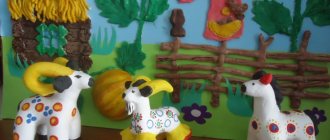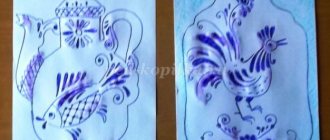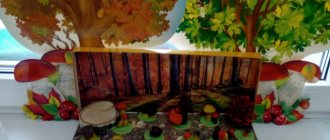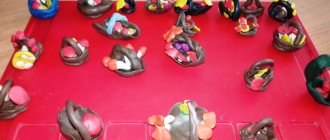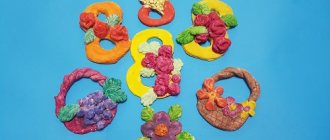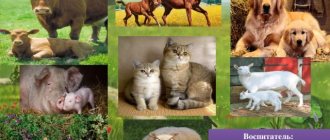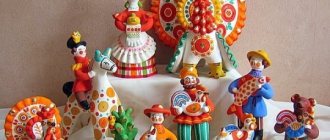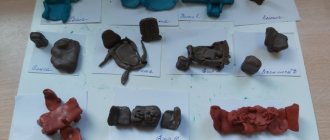Modeling “Beautiful Bird”
(According to the Dymkovo toy)
Program content. Learn to sculpt an object consisting of several parts. Strengthen the pinching technique with your fingertips (beak, tail); the ability to firmly fasten parts, pressing them tightly against each other. Learn how to model a folk (Dymkovo) toy.
Methodology for conducting GCD. Examine a toy bird with your children, highlight the parts of the figurine and determine their shape. Ask how you can make a bird, where to start; determine which part of the bird is larger: the body or the head. Call the child to the board to show how to sculpt the body of a bird.
When the children are sculpting the body of the bird, ask them to show with their hands in the air how they will sculpt the head. When the guys are sculpting the head, ask how they can sculpt the bird’s beak.
Invite those who know how to do this to demonstrate the technique of pinching with two fingers on a lump of clay (plasticine). During the sculpting process, remind children of the need to firmly fasten the parts together, pressing them together.
You can give the kids who finish their work earlier than others additional lumps of clay (plasticine) and offer to make grains (small lumps of clay), worms, or anything else that makes sense for the bird.
Materials. Toy bird. Clay or plasticine, boards (for each child).
Connection with other activities. Observing birds on a walk, looking at illustrations and toys. Comparison of different birds. Didactic game “Which bird is missing?” Introduce children to the images of Dymkovo birds.
Appendix 5
Appendix 6
Experimental activity on the topic: “Sand. Properties of sand. Making Easter cakes from sand."
Goal : To develop the cognitive activity of children in the process of experimentation. Help expand children's knowledge about the properties of dry and wet sand, activate speech and enrich children's vocabulary.
Training tasks:
Introduce children to the properties of sand.
Learn to handle sand carefully, do not spill it.
Renew your interest in working with sand.
Develop the ability to put forward hypotheses, compare and draw conclusions.
Learn the new game “Grains of Sand” with the children.
Developmental tasks:
Develop children's hand motor skills.
Enrich your vocabulary.
Develop skills of interaction with peers in the process of joint activities.
Educational tasks:
Cultivate feelings of empathy and compassion.
To develop cultural and hygienic skills in children (neatness, neatness).
Form of implementation: Subgroup, practical activity.
Materials: large children's sandbox, set of molds, scoops, watering cans, napkins.
The teacher shows the children sand.
- Look what I have in my hands? (Sand.)
- Right. This is sand. Tell me, do you like to play with sand? (Answers.) Let's play with it a little and get acquainted with its properties.
But first, let's agree that during the game:
— we don’t put sand in our mouth;
- don’t rub your eyes with dirty hands;
- We don’t cover ourselves with sand.
Go to the sandbox and touch the sand with your hands.
— What color is the sand? (Brown).
Educator: I’m pleased, I feel the coolness of the sand. What do you feel (children’s statements).
Let's start the process: how to make a bird?
I remembered how they made bird feeders in winter. At this difficult time for birds, the topic for the modeling lesson “Birds at the feeder” is relevant. Feeders are also very useful: children look at the image of birds that “dine” on grains and then try to depict sparrows, tits or bullfinches in different poses. Then we put the figures in the feeder, sprinkle grains or crumbs and admire the composition.
In the summer, you can invite your child to watch the bird peck the grains and make his own “dining” bird. You know from your own experience that some of us can recreate something from memory, while others need a sample before their eyes. So the kids are different too. It’s better to have a visual illustration of a pecking sparrow on hand so that the child learns to sculpt “from life.” Next time he will be able to depict something without a picture...
Even junior group 2 can make a simple bird like a sparrow: you need to take a plate of plasticine and divide it into 3 parts. One - the largest - is the body, the second smaller one is the head, and the rest will be useful for details. Knead a large piece and roll it into a ball. Then we form an egg from it. We flatten one end to create a tail. Roll a smaller piece into a ball - this is the head. We attach it to the body. From the remainder we pinch off a piece for the beak and paws. We can draw the wings and eyes in a stack, or do them separately. This is the simplest option. To begin with, you can do everything with one color, and then we will teach you to use plasticine of different shades to convey the natural color of the birds’ feathers.
Of course, the middle group makes the figures more complex. Children of this age are more interested in sculpting figures from cartoons. So show them how to make their favorite Angry Bears. It’s easy to sculpt them: we roll a ball of the desired color, it depends on the character, they are multi-colored, as we know. And to this ball we attach details according to the model: beak, big eyes, crests, wings, paws. Here children learn not only to convey the shape with the help of plasticine, but also the character of the character. Each bird has its own character, which is conveyed through details.
Summary of the lesson in the senior group “Sculpting a bird based on the Dymkovo toy.”
Summary of the lesson in the senior group “Sculpting a bird based on the Dymkovo toy.”
Educator: Baykhonova E.A.
Program content:
• Continue to introduce children to Dymkovo toys
.
• To cultivate an aesthetic attitude towards the products of folk craftsmen and respect for their work.
• Continue to teach children to sculpt the details of the overall figure from separate pieces of clay, and then smoothly connect them using daubing (stacks)
.
• Practice rolling, flattening, and pulling techniques when performing individual elements.
• Develop fine motor skills of the hand.
• Learn to draw patterns on the bird in a stack.
Material: Clay toys
, illustrations with
Dymkovo toys
, boards according to the number of children, water bowls, rags for hands, clay, stacks, tape recorder. Music: Russian folk, classical by D. Shostakovich.
Progress of the lesson
Calm Russian folk music sounds. - Hello guys! Do you want to know what I'm rich in today? Just smile at the guests first, bow, and quickly turn to me. – I made toys
Yes, I invited you here.
I want to ask you a riddle: And these toys are not simple
, but magically painted: snow-white, like birch trees, circles, squares, stripes - the pattern would seem simple, but you can’t look away!
-What toys is the riddle about
?
( Dymkovsky )
.
The teacher invites the children to “ Dymkovo village ”
Breathing exercises.
- What a whiff of smoke
!
(children inhale deeply through their noses)
.
– Do you smell smoke? - Look who's meeting us? (young ladies, horses, etc.)
Game:
“Zarya Zaryanitsa” (the teacher and children are in the Dymkovo village )
- Why are
the toys
you see called
Dymkovo
?
— What material are they made of? — What did Dymkovo masters
?
— Why did they love to sculpt animals and people? — What mood do such toys
?
— What paints do Dymkovo masters
?
— What elements of Dymkovo painting do you know
?
-Come on, guys, we’ll dream... Sit on the carpet, close your eyes, listen to my voice and music (relaxation)
— We brought clay from a distant hillock. Well, let's get to work, miracle masters! I'll make a horse, I'll pet it. And I’ll attach a saddle with fringe on the back. Let's mold, dry - and into the oven! And then we'll write it down. We will bake toys
, the stove is glowing with heat.
And in the oven there are not rolls, but in the oven there are Easter cakes, Not crumpets, not cheesecakes, but in the oven there are toys
!
- Now, guys, sit down at the tables.
Someone skillfully made holes in the back of the bird. And the tit suddenly began to sing with the voice of spring itself. These birds are vocal and elegant like calico! Whoops, whew, whew, whew! Whoops, whoops, I see the nest! (riddle-poem about a bird)
— What parts does a bird consist of? (head, body, tail, wings)
.
– How will we divide the clay to sculpt the bird? - What shape does the head have? (ball)
.
- What shape does the body have? (ovoid)
.
— How are we going to sculpt the wings? (flatten)
.
— How are we going to sculpt the beak and tail? (pull out)
.
- What will we use to connect the head and body? (using stacks)
. — We draw the plumage of the bird in a stack.
The teacher reminds children of the rules for working with clay:
- What if your hands get dry? (wet with water)
.
— What if the clay cracks? (wipe with water, drainage, a wet cloth)
.
- If your hands are dirty? (wipe with a cloth)
.
To prepare our hands for work, let's play with our fingers.
Finger game “Ten birds - a flock ”
(Clench your fists and bend one finger to the name of each
bird
)
Sing along, sing along, Ten birds - a flock
: This
bird is a nightingale
, This
bird is a sparrow
, This
bird is an owl
.
Sleepy little head: This bird is a waxwing
, This
bird is a corncrake
.
This bird
is a gray feather bird.
This is a finch, This is a swift, This is a cheerful siskin... Well. And this is an evil eagle. Birds
,
birds go home
!
(The game is played 2 times at different paces)
.
Children do their work to the music.
Phys. Minute "Rooster"
A rooster walked along the shore. Steps with high lifting of legs and arms. I slipped and fell into the river! Move your arms in a circular motion, squat down. The rooster will know that from now on he will rise and shake his finger. You have to watch your step. Bend forward.
Final part
What did we do today? What folk painting did you and I use?
Summarizing.
3
